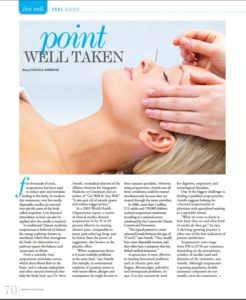 For thousands of years, acupuncture has been used to reduce pain and stimulate healing in the body. In modern day treatments, very fine sterile, disposable needles are inserted into specific parts of the body called acupoints. Low electrical stimulation or heat can also be applied after the needle is inserted.
For thousands of years, acupuncture has been used to reduce pain and stimulate healing in the body. In modern day treatments, very fine sterile, disposable needles are inserted into specific parts of the body called acupoints. Low electrical stimulation or heat can also be applied after the needle is inserted.
In traditional Chinese medicine, acupuncture is believed to balance the energy pathways known as meridians, which flow throughout the body. An obstruction in a pathway upsets this balance and causes pain or illness.
From a scientific view, acupuncture stimulates nerves, which alters blood flow to the brain, and it releases endorphins and other natural chemicals that help the body heal, says Dr. Steve Amoils, co-medical director of the Alliance Institute for Integrative Medicine in Cincinnati and coauthor of “Get Well & Stay Well.” “It also gets rid of muscle spasm and sedates trigger points.”
In a 2003 World Health Organization report, a review of clinical studies showed acupuncture to be 55 to 85 percent effective in treating chronic pain, comparable to many pain-relieving drugs and far better than the power of suggestion, also known as the placebo effect.
“Where acupuncture shines is it treats multiple problems at the same time,” says Amoils. For example, in conventional medicine, if a patient comes in with tennis elbow, allergies and constipation, he might be sent to three separate specialists. However, using acupuncture, Amoils says all three conditions could be treated simultaneously because they are treated through the same meridian.
In 2006, more than 3 million U.S. adults and 150,000 children received acupuncture treatments, according to a national survey conducted by the Centers for Disease Control and Prevention.
“The typical patient is a more educated female between the ages of 35 to 65,” says Amoils. “They usually have more disposable income, and they often have a symptom that has defied medical treatment.”
Acupuncture is most effective in treating functional problems such as chronic pain and fatigue, fibromyalgia, infertility and menopausal problems, he says. It is also commonly used for digestive, respiratory and neurological disorders.
One of the biggest challenges is finding a qualified acupuncturist. Amoils suggests looking for a licensed acupuncturist or physician with specialized training at a reputable school.
“What we want to know is, how busy they are and what kind of results do they get,” he says. A thriving, growing practice is often one of the best indicators of patient satisfaction.
Acupuncture costs range from $50 to $150 per treatment, depending on the practitioner, number of needles used and duration of the treatment, says Amoils. Although acupuncture is gaining popularity, health insurance companies do not usually cover the treatments.